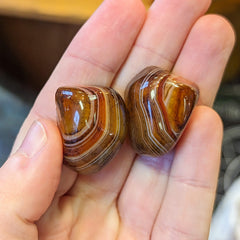Sardonyx is a beautiful crystal that has been popular amongst mineral collectors and jewellers for centuries, with finds dating back 4000 years to the Egyptian, Greek and Roman empires. It has a striking combination of deep red-orange colouration with black and white stripes. However, with its popularity, over the last few years the market has been flooded with fake Sardonyx that has been treated to give it the bright colours. In this blog post, we'll guide you on how to spot the tell tale signs of fake Sardonyx.
What is Sardonyx?
Sardonyx is a variety Agate, which is a type of Chalcedony that is made up of parallel bands of different colors. In the case of Sardonyx, these bands are typically a mixture of brown or red Sard (a slightly more muted, darker coloured Carnelian), and black and white Agate known as Onyx. These contrasting bands create a distinctive and eye-catching appearance.
The below image from Gem Select shows natural rough Sardonyx.

How Do They Make Fake Sardonyx?
Fake Sardonyx is usually created through a treatment process involving naturally grey banded Agate from Madagascar. This process typically includes subjecting the Agate to sugar acid treatment. The acid treatment alters the color and appearance of the agate, giving it the vivid red-orange and white contrast that mimics real Sardonyx. Boiling it in Nitric Acid to give it a red brown colour has also been known.
The below image shows the type of treated grey banded Agates from Madagascar that are being sold as Sardonyx:

How Do You Spot It?
To spot fake Sardonyx, watch out for the following:
-
Pronounced Thin Black Lines: Genuine sardonyx has a much more subtle colour pattern, whereas these treated Agates tends to have thin black lines
-
Bright Contrast: these treated "Sardonyx" have a bright and vivid contrast between the red or orange and the black and white bands. Natural Sardonyx displays a much more muted colour pattern, more towards brown than reds and oranges.
-
Cutting the Stone: An effective way to identify fake Sardonyx is to cut the gem. Authentic Sardonyx will show that the colour runs through the stone, while fake Sardonyx will show a white/grey colour inside, as the treatment does permeate all the way through the crystal.
This shows two sides of the same tumble, cut in half to show the white interior of the Agate:


How Rare is Natural Sardonyx?
Natural Sardonyx is relatively rare. While you can find a wide variety of Sardonyx jewelry on the market, many of these pieces are created from treated agate, as mentioned earlier. Natural Sardonyx tends to have a more muted brownish hue, with less pronounced contrast between the bands. This natural variety, though less vibrant, is highly prized by collectors for its authenticity.
Be aware that almost all polished red and black Sardonyx on the market, particularly in palm stones, will be treated in this way, and many vendors are unaware of this.


michael cyrus
Hello, my name is Michael. I have a love and relationship with beautiful gemstones. I love them inexpressibly and I collect the most beautiful stones.